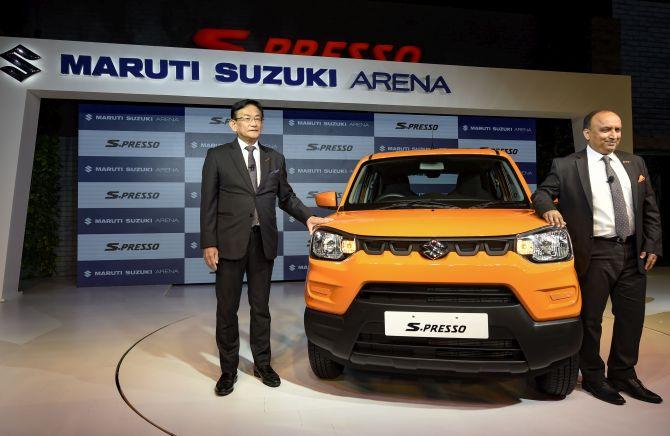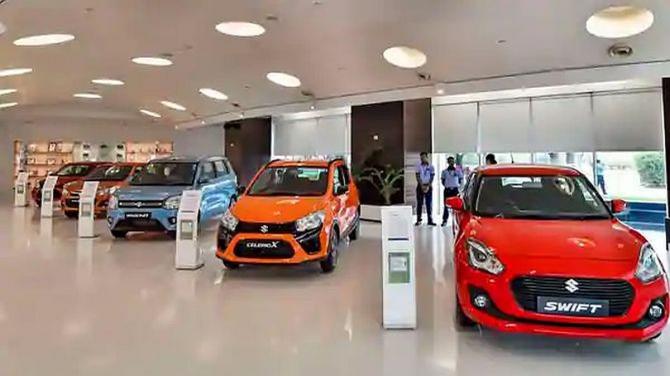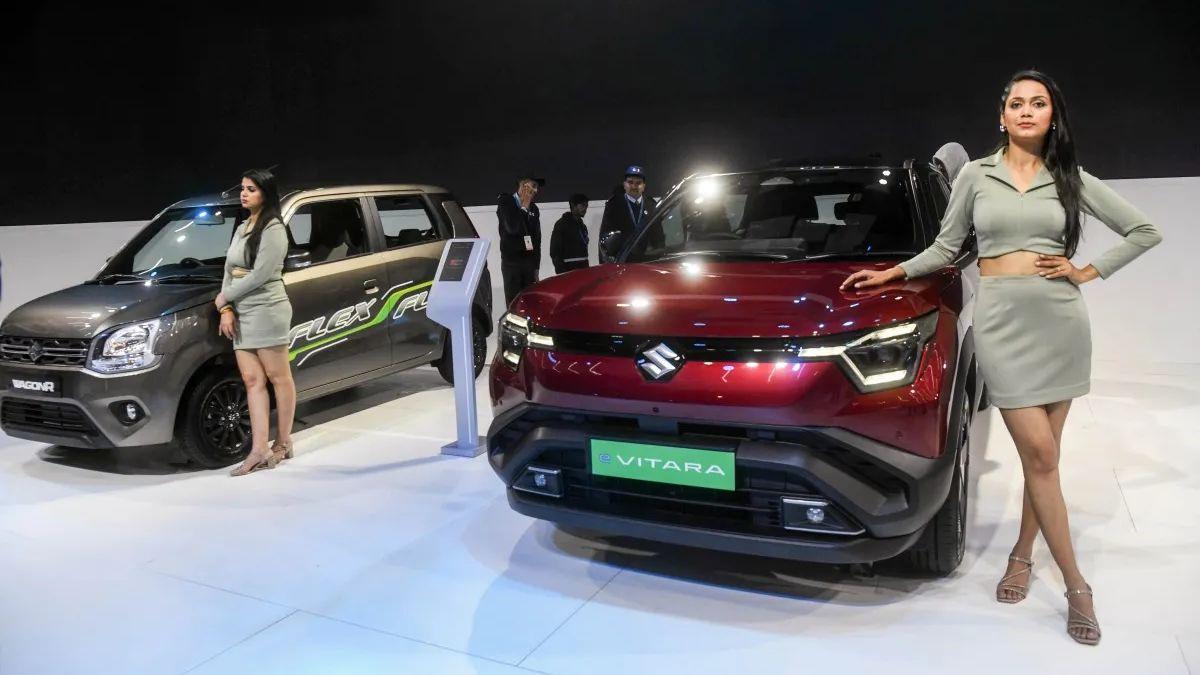The growing rift between MSIL and rival automakers has complicated the government’s efforts to finalise the CAFE norms.

Kindly note the image have only been published for representational purposes. Photograph: ANI Photo
Soon after Maruti Suzuki (MSIL) sought relief under the Corporate Average Fuel Efficiency (CAFE) norms, citing lower emission by small cars, Mahindra & Mahindra (M&M) has hit back.
Small cars account for over half of carbon dioxide (CO2) emissions from all passenger vehicles (PVs) in India, and giving them relief from the upcoming CAFE norms would undermine the country’s global competitiveness, Mahindra & Mahindra has told the ministry of road transport and highways, it is learnt.
M&M’s July 9 letter to the ministry, in response to the relief sought by MSIL under the CAFE-III and CAFE-IV regimes, indicates the deep divide in the auto industry.
The growing rift between MSIL and rival automakers has complicated the government’s efforts to finalise the CAFE norms.
According to sources, the Bureau of Energy Efficiency (BEE), under the ministry of power, is in the final stages of drafting CAFE-III and CAFE-IV but wants to ensure the framework is seen as balanced and equitable. CAFE-III and CAFE-IV regimes are scheduled to be implemented between April 2027 and April 2037.
Earlier this month, MSIL Chairman R C Bhargava had said small cars emit less per passenger, use fewer materials, and consume less fuel and claimed that rival carmakers are opposing concessions out of self-interest, rather than the country’s priorities.
CAFE norms set CO2 emission limits (in grams per kilometre) for automakers’ fleets, effectively pushing manufacturers to improve fuel efficiency and adopt cleaner technologies.
CAFE-II norms are currently in force, while the upcoming CAFE-III and CAFE-IV norms will be significantly stricter.

Photograph: Kamal Singh/PTI Photo/Rediff Archives
In a key clarification, M&M defined small cars using the GST framework — vehicles under 4 metres in length and with engine capacities of up to 1,200 cc (petrol) or 1,500 cc (diesel) — a definition that also includes compact SUVs like the Kia Sonet.
MSIL, in contrast, has sought relief specifically for cars weighing under 1,000 kg, a narrower classification focused primarily on entry-level hatchbacks and sedans.
In its letter, M&M argued that small cars make up about 60 per cent of the PV market, and they contributed 53 per cent of the industry’s CO2 emissions in FY25.
“Granting concessions would not only perpetuate this level of emission but also lock it in for the future by removing CAFE penalty avoidance incentive for innovation in this segment towards fuel efficiency and lower emission,” M&M said.
It warned any possible relaxation could be a “significant setback” to the national goals of reduction in vehicular emissions, increased EV adoption, and global competitiveness.
“Our national goal of 30 per cent EVs by 2030 will take a hit if only larger cars focus on EV. Globally, OEMs (original equipment manufacturers) meet CAFE targets by intentionally deploying EVs in their vehicle lineups, regardless of the size of the cars,” it mentioned.
The relative lack of innovation in the small car segment will hold the industry back, reducing Indian industry leverage in a post-FTA (free-trade agreement) future with more free trade, it noted.

Photograph: PTI Photo/Rediff Archives
M&M stated that there should be “no relaxation of target” under CAFE-3 and CAFE-4 norms for small cars and that electrification of the small car segment could be a growth catalyst.
“Electrification of this segment can be a compelling value proposition for first-time buyers due to favourable total cost of ownership,” it wrote.
M&M did not respond to Business Standard’s queries on this matter.
According to Society of Indian Automobile Manufacturers (Siam) data, M&M sold 551,487 vehicles in FY25 — 20 per cent year-on-year growth — all of them SUVs.
Maruti Suzuki, with a broader portfolio of hatchbacks, sedans, and SUVs, sold 1.76 million units, flat from FY24, amid continued weakness in demand for hatchbacks and sedans.
According to the BEE’s draft proposal, automakers would be required to cut average fleet emissions by 33 per cent under CAFE-3 compared to CAFE-2.
M&M argued that this would put an “enormous burden on OEMs”, especially given the pace of EV adoption and infrastructure development.
It pushed for a more achievable target of a 21 per cent reduction, translating to 92.9 g/km under the Modified Indian Driving Cycle, India’s standard lab test for emissions and fuel efficiency.
M&M has proposed that EVs be given additional weight in the compliance formula. It recommended a “volume derogation factor” of 4 for battery EVs, meaning each EV sold would count as four units for meeting emissions targets, which, it argued, would make investment in EVs and related infrastructure more attractive.
Sources said a few automakers have told the government that hatchbacks and sedans are losing out not just due to pricing, but also because buyers now prefer SUVs for their features, higher ground clearance, spaciousness, and aesthetics. With easier financing options, the price gap is no longer a major barrier.
There are also safety concerns. Some manufacturers have pointed out that structurally safer vehicles tend to be heavier due to reinforcements and multiple airbags.
Providing relief to vehicles under 1,000 kg, they warned, could disincentivise safety features.

In light of the upcoming stricter CAFE-3 norms, several automakers have requested policy stability.
If no relief is granted for small cars, they want long-term assurance on existing incentives such as the 5 per cent GST rate for EVs and multi-year commitments under the PLI scheme, rather than annual reviews.
Earlier this month, Bhargava had said the CAFE rules were based on the European market, which has far fewer small cars.
“My understanding is that the rules are weighted in favour of big cars — despite the fact that smaller cars emit lesser emissions per passenger, use lesser materials and also lesser fuel.”
He added that two-thirds of the population depend on scooters and motorcycles for personal transportation.
“This very large segment requires a safe, comfortable, and affordable means of transport, which logically means a small car. All regulations and taxes should promote this segment, not only the car segment, which caters to the rich.”
Feature Presentation: Rajesh Alva/Rediff




